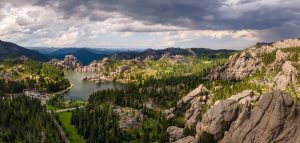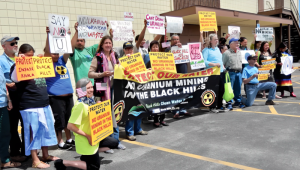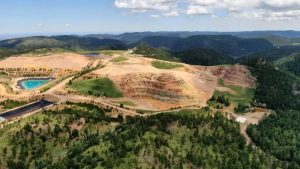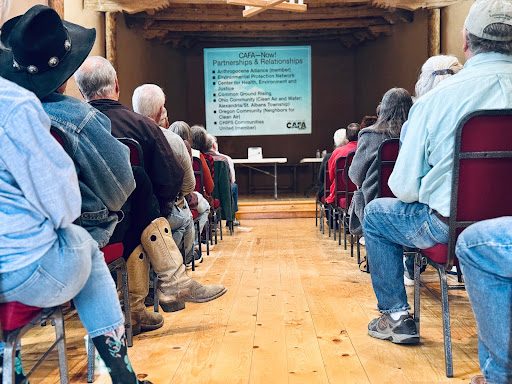
About 50 miles west of Rapid City, in the heart of South Dakota’s Black Hills, there is a meadow. It sits some 6,000 feet above the sea. It is a place where the sky feels big and wide. It is windswept, exposed to the elements, carpeted by native grasses that bend and wave and ripple in the breeze. It is surrounded by mountains forested with ponderosa pine, and in the summertime, wildflowers bloom. By day, deer and elk graze, and eagles circle overhead. At night, the stars shine bright.
The Oceti Sakowin (otherwise known as the Great Sioux Nation, which is a union of Dakota, Lakota, and Nakota peoples) call this rolling grassland Pe’ Sla, a name that translates to English as “the heart of everything that is.” Lakota creation stories say that, before the Lakota people emerged on the earth from Wind Cave, they lived in the earth under Pe’ Sla. “Besides being part of their creation story, Pe’ Sla plays a crucial role in the star knowledge of the Sioux,” attorney, Indigenous activist, and member of the Oglala Sioux Tribe Chase Iron Eyeswrites. “Ceremonies essential to their culture and beliefs, that Tribal elders and spiritual leaders explain help keep the Universe in harmony, must be conducted at Pe’ Sla.”
Pe’ Sla is a sacred place to the Sioux.
Soon, it could be a graphite mine.
In April of this year, a company called Pete Lien & Sons filed a proposal to conduct exploratory drilling for graphite in the Black Hills National Forest. The Rochford Mineral Exploratory Drilling Project, as it is known, aims to construct 18 drill pads, some within or adjacent to the Pe’ Sla boundary. If the project is approved, these drills will burrow one thousand feet into the very earth in which the Lakota people once lived, according to their creation myths. Trees will be felled. Roads will be built. If battery-grade graphite (the kind used in lithium-ion batteries) is discovered, a full-fledged mine could be established.
The project has yet to be green-lit by the Forest Service, but it is already facing fierce opposition from the Great Sioux Nation, along with many Indigenous rights and environmental groups, who argue that the project threatens to desecrate sacred land and contaminate the Rapid Creek watershed, which supplies water for Rapid City, the state’s second largest municipality. NDN Collective, an Indigenous-led nonprofit based in Rapid City, denounced the project as “a calculated and willful attack on Indigenous sovereignty, history, and human rights.”
“Pe’ Sla is a sacred site with federal Indian trust status—yet is still at risk of mining, which should raise alarm bells for everyone in the Black Hills area and beyond as the success of this proposal could make all land that much easier for mining companies to contaminate forever,” Taylor Gunhammer, NDN Collective’s local environmental organizer and a member of the Oglala Lakota Nation, said in a press release in May.
Alarm bells across the Black Hills are ringing. The Rochford Mineral Exploratory Drilling Project is just one of over 13,000 active mining claims in the region. Combined, these claims make up an area of about 271,000 acres. “That’s 20 percent of the whole Black Hills that could be subject to mining,” says Lilias Jarding, executive director of the Black Hills Clean Water Alliance, a nonprofit organization and A2 member fighting to protect the Black Hills from mining.
Some of these mining projects, like the Rochford Mineral Exploratory Drilling Project, are looking for graphite. Others are after gold, silver, tin, lithium, and uranium. Many have been spurred by an executive order from March 2025 calling for increased American mineral production.
The Black Hills are on the brink of a mining boom.
To the Lakota and other Oceti Sakowin peoples, history seems to be repeating itself.
“It’s pretty much mirroring what we’ve seen with extractive industries for the last 150 years,” says Dov Korff-Korn, legal director of Sacred Defense Fund, a Native-led nonprofit and A2 member working to protect Indigenous rights and sacred sites. “Now, we’re just seeing another chapter of it.”

The Lakota call the Black Hills Pahá Sápa—“hills that are black”—for the forests of ponderosa pine that blanket the mountain range. (Photo courtesy of Save the Black Hills)
The Oceti Sakowin have lived in the Black Hills for countless generations. They call them Pahá Sápa, and say that this island of mountains and forests rising up from the Great Plains has been their home since time immemorial. All of Pahá Sápa is sacred to the Sioux, and all of Pahá Sápa once belonged to the Great Sioux Nation.
In the 1868 Treaty of Fort Laramie, the United States formally recognized the Black Hills as part of the Great Sioux Reservation, setting them aside for “absolute and undisturbed use and occupation” by the Great Sioux Nation. Six years later, in violation of the treaty, General George Armstrong Custer led an expedition into the Black Hills and discovered gold.
Thousands of miners and prospectors flocked to the region, leading to the Great Sioux War of 1876. In the wake of the war, the United States cut off rations and supplies promised to the Sioux under the 1868 treaty unless they agreed to sell the Black Hills. The Sioux refused. The United States unilaterally seized the Black Hills in 1877.
In his testimony before a U.S. House committee in 2023, Oglala Sioux Tribal President Frank Star Comes Out stated: “We said then—and we have repeated for generations—that the Black Hills are not for sale.”
The United States didn’t listen. Tens of thousands of settlers moved into the Black Hills over the next few years. Mines were built. Some proved profitable. The Homestake Mine, for example, was established in 1876. It would go on to become the largest and deepest gold mine in North America. After unearthing 40 million ounces of gold (and polluting the Whitewood Creek watershed with arsenic, mercury, and other heavy metals leached from the mine’s tailings and waste rocks), the mine closed in 2002.
The late-1940s brought another crop of miners to the Black Hills, looking not for gold, but for uranium to be used in the production of nuclear weapons. Hundreds of uranium mines and exploratory drill sites sprang up in the southwestern Black Hills over the next few decades. Many were abandoned and never properly reclaimed. Some continue to leach uranium, radiation, and heavy metals into the Cheyenne River, polluting the drinking water supply of the Pine Ridge Reservation.

Black Hills Clean Water Alliance members protest the Dewey-Burdock Project in May 2017. (Photo courtesy of the Black Hills Clean Water Alliance)
Uranium mining persisted in the Black Hills until the early 1980s, when a group of concerned citizens came together to form the Black Hills Alliance. “It was an alliance that was really unusual at the time because there were Native and non-Native people involved in the group and there were ranchers involved with environmentalists,” Jarding, who was a member of the organization, says of the Black Hills Alliance. “The alliance stopped uranium activity in the Hills at that time. Then nothing happened around uranium here for a while.”
Little mining happened in the Black Hills at all over the next few decades. After the Homestake Mine shut down in 2002, another open-pit gold mine called the Wharf Mine became—and continues to be—the only active large-scale mining operation in the Black Hills.
That could soon change.. . .Now, a new wave of mining proposals threatens sacred sites and waterways across the Black Hills. Proposals like the Rochford Mineral Exploratory Drilling Project. Sacred sites like Pe’ Sla. Waterways like Rapid Creek. As of January 2025, there were 13,104 active mining claims in the Black Hills, according to a report from the Black Hills Clean Water Alliance. New claims have been staked since then, and the organization is currently working on a new report to be published in the coming weeks.
The Black Hills Clean Water Alliance is also partnering with Sacred Defense Fund, NDN Collective, Earthjustice, Anthropocene Alliance, and other groups to build a coalition called “Save the Black Hills.” In a sense, the coalition is the next chapter of the movement that the Black Hills Alliance built in the 1980s—a movement that mobilized thousands of people and defeated mining projects proposed by companies the likes of Exxon, Conoco, and Union Carbide. It is an alliance of Native and non-Native people, ranchers and environmentalists, civilians and veterans, liberals and conservatives, youth and elders, uniting to protect the Black Hills from extractive industry.

The Gilt Edge Mine, an abandoned 360-acre open-pit gold mine, is located about six miles east of Lead, South Dakota. (Photo courtesy of the Black Hills Clean Water Alliance)
“When people work together to fight these projects, they have success,” Lilias Jarding says. Consider the Dewey-Burdock Project, she continues. The 12,000-acre in-situ recovery uranium mine was first proposed in 2009, but legal pushback from the Great Sioux Nation, Black Hills Clean Water Alliance, NDN Collective, and other groups have prevented the project from moving forward. Another win came in December 2024, when then-Interior Secretary Deb Haaland, the first Native American cabinet member in U.S. history, signed a 20-year mining ban on 20,500 acres of public land surrounding the Pactola Reservoir, the largest and deepest reservoir in the Black Hills. Another win, Jarding and many others hope, will come at Pe’ Sla.
During its first public comment period, the Forest Service received more than 2,100 public comments regarding the Rochford Mineral Exploratory Drilling Project. “The vast majority of comments were against the proposed project,” Jarding says. The Forest Service is currently reviewing these comments. Next steps are expected by the end of October.
“The Forest Service could propose a withdrawal because of the public outcry against the project, like what happened with the Pactola Reservoir,” Jarding says. “Or it could be a decision to let them go ahead and drill with no further environmental review. Or they could decide to do an environmental study. A full environmental impact statement is rare for exploration projects, but there are so many issues with this one. There’s municipal water. It’s a sacred site. It’s a unique landscape biologically and geographically.”
The fate of Pe’ Sla—and much else of the Black Hills—hangs in the balance.
Newsletter Sign Up
Don’t miss any of our newsletters!

